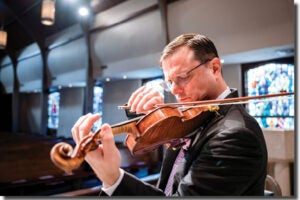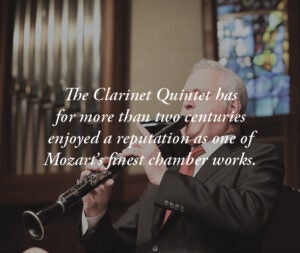In Depth: Combinations
Three composers, six artists, three distinct musical combinations!
 Greenville – Fri, Nov 8 @ 7:30 PM
Greenville – Fri, Nov 8 @ 7:30 PMRaleigh – Sun, Nov 10 @ 3:00 PM
Buy Tickets
Have you ever wondered why composers write music for certain combinations of instruments? In some cases, the answer may be simple. The string quartet, for example, is a very common type of ensemble – so common that it forms its own massive sub-genre of classical music. It’s no suprise, then, that composers frequently write for this combination of two violins, one viola, and one cello. Sometimes, however, the answer might be more specific to a particular set of circumstances.
Take Sergei Prokofiev’s Overture on Hebrew Themes, for example. While a string quartet may be common, a string quartet plus piano PLUS clarinet most definitely is not. This peculiar instrumentation arises from the fact that the work was written for a specific group of musicians: an international touring ensemble called Zimro. Hailing from Russia, Zimro’s concerts featured a combination of existing Jewish folk music and newly-composed works. So, when they crossed paths in the United States with Sergei Prokofiev – another Russian on an extended international stay – Zimro commissioned him to compose a work using themes collected by the group’s clarinetist. The exceedingly rare combination makes this Four Seasons performance of the original instrumentation a special treat; the work is more widely known and performed in a chamber orchestra arrangement completed by Prokofiev fifteen years after the sextet’s 1920 premiere.
 Wolfgang Amadeus Mozart’s Clarinet Quintet was the product not of a commission, but rather of inspiration. Mozart’s first substantive experiences with the clarinet came in the 1770s, a time when the instrument – bolstered by a recent series of innovations – was only just beginning its journey as one of the principal wind instruments of classical music. Mozart was immediately fascinated by the clarinet’s potential. Then in the early 1780s, he crossed paths with the man who would become his clarinet muse: the Austrian clarinetist Anton Stadler. The ensuing musical partnership was a fruitful one for generations of audiences and clarinetists alike, resulting in, among other works, Mozart’s Kegelstatt Trio, Clarinet Concerto, and the Clarinet Quintet. Scored for string quartet and clarinet, this quintet has for more than two centuries enjoyed a reputation as one of Mozart’s finest chamber works.
Wolfgang Amadeus Mozart’s Clarinet Quintet was the product not of a commission, but rather of inspiration. Mozart’s first substantive experiences with the clarinet came in the 1770s, a time when the instrument – bolstered by a recent series of innovations – was only just beginning its journey as one of the principal wind instruments of classical music. Mozart was immediately fascinated by the clarinet’s potential. Then in the early 1780s, he crossed paths with the man who would become his clarinet muse: the Austrian clarinetist Anton Stadler. The ensuing musical partnership was a fruitful one for generations of audiences and clarinetists alike, resulting in, among other works, Mozart’s Kegelstatt Trio, Clarinet Concerto, and the Clarinet Quintet. Scored for string quartet and clarinet, this quintet has for more than two centuries enjoyed a reputation as one of Mozart’s finest chamber works.
The Mozart and Prokofiev works were both written for ensembles that are varying degrees of unique. But even standard combinations of musicians can be the result of very specific groupings of people. In November of 1938, Dmitri Shostakovich’s String Quartet No. 1 was given its Moscow premiere by a group known as the Beethoven Quartet. So impressed by Shostakovich were the Quartet’s musicians, that they asked him to compose for them a work in which the composer could join them in performing: a piano quintet. One of Shostakovich’s most-beloved chamber works, the massive, five-movement Piano Quintet in G Minor, Op. 57 opens with a two-movement prelude and fugue inspired by J.S. Bach. And just like that of Mozart and Stadler, the relationship between Shostakovich and the Beethoven Quartet was an impactful one. In addition to the Quintet, the Beethoven Quartet would go on to premiere 13 of Shostakovich’s 15 string quartets, several of which were dedicated to either the group or its individual members.
Four Seasons is proud to present Combinations in Greenville on November 8 and in Raleigh on November 10. Founder & artistic director Ara Gregorian (viola) is joined by pianist Ieva Jokubaviciute, clarinetist Alan Kay, violinists Yura Lee and Jesse Mills, and cellist Peter Stumpf for a program that features Prokofiev’s fun and characterful concert-opener, Mozart’s beloved Clarinet Quintet, and Shostakovich’s dramatic and riveting Piano Quintet.
